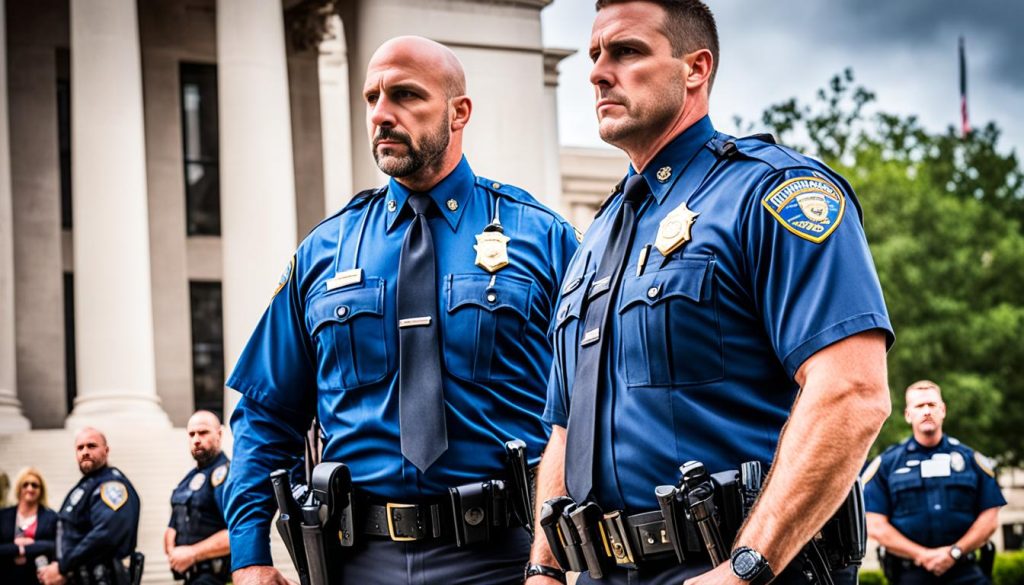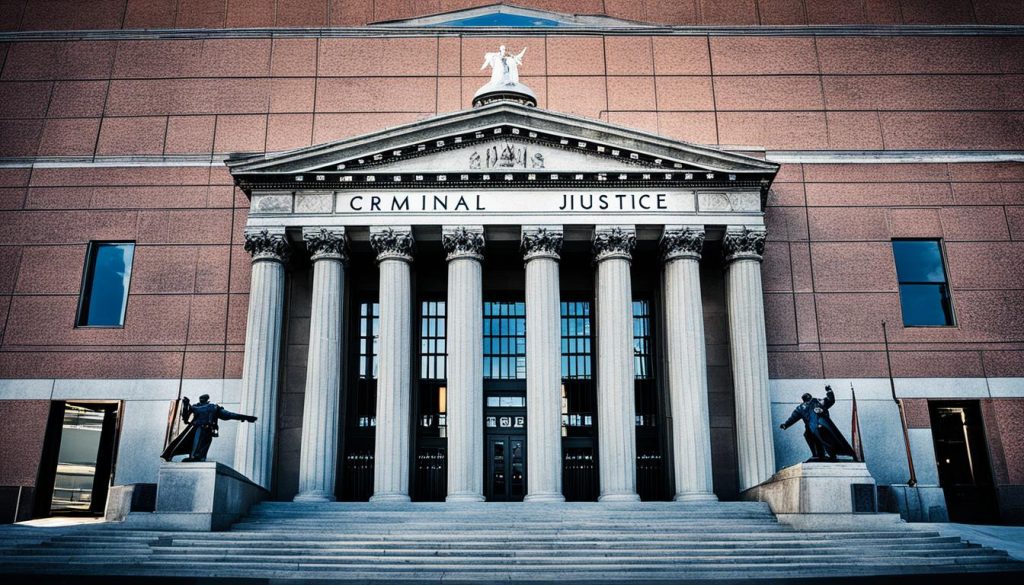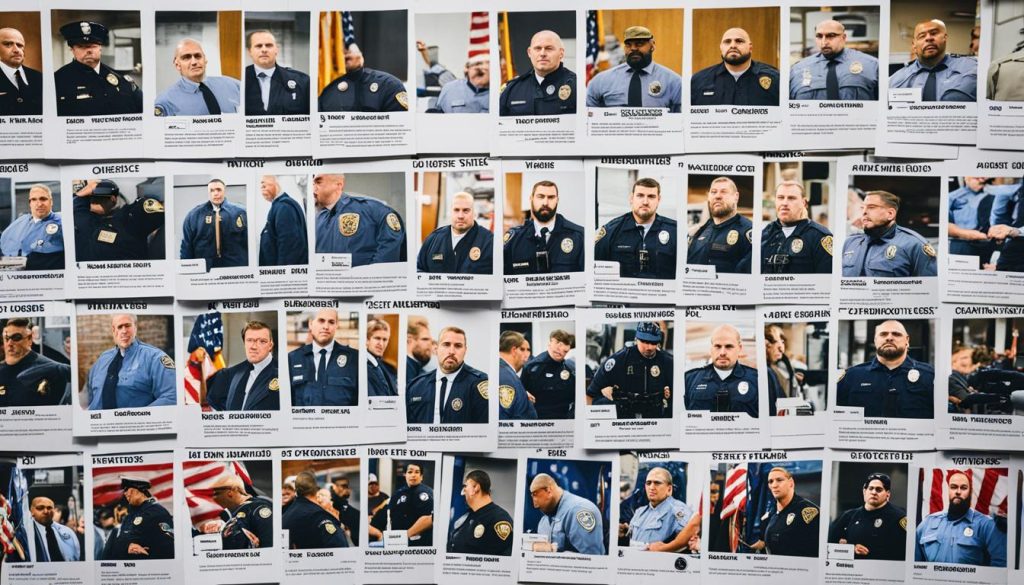The criminal justice system in the United States is complex. It includes law enforcement, courts, and correctional facilities. These work together to keep us safe and follow the law1.
At its core, the system follows the rule of due process. This means people accused of crimes get their rights and protections. The process comes from English common law, with steps and decisions for fair justice2.
Even though each place in the USA handles cases differently, there are common steps. These steps protect our rights and keep the legal process fair. The system has government and private groups working together to enforce the law and keep peace3.
Key Takeaways
- The criminal justice system in the USA includes law enforcement, courts, and corrections. Government and private agencies are key.
- The process comes from English common law and aims to protect accused people’s rights.
- Though places may differ, there are common steps for fairness and integrity in the legal process.
- A complex network of federal, state, and local agencies work together for safety and law enforcement.
- Knowing how the criminal justice system works is important for legal rights and being an informed citizen.
Introduction to the Criminal Justice System
The criminal justice system in the United States is a complex network. It includes law enforcement, the court system, and correctional facilities4. This system aims to uphold the rule of law, keep public safety, and ensure due process for those accused of crimes, as the U.S. Constitution guarantees4.
At the core, the system believes crimes against an individual are also crimes against the state4. The government prosecutes offenders to deter future crimes and prevent them, promoting safety4.
The criminal justice process in the U.S. has several stages, each with its own procedures and requirements4. These stages include entry, prosecution, adjudication, sentencing, and corrections4.
Law enforcement agencies are key in the system. They use crime reports, field discoveries, informants, and investigations to find suspects and catch offenders4. Prosecutors then decide if to charge someone with a crime based on this information4.
The U.S. court system has a multi-tiered structure, with5 94 district courts5, 13 circuit courts, and5 one Supreme Court of the United States5. There are over5 670 district court judges and circuit court judges are appointed for life by the President and confirmed by the Senate5.
The criminal justice system in the U.S. protects the rights of the accused and victims, promoting public safety and the rule of law4. It’s a complex process that involves many agencies and stakeholders to ensure justice is fair and effective.
Law Enforcement in the United States
Law enforcement agencies at the federal, state, and local levels are key to keeping the public safe and upholding the law in the U.S6.. The FBI, DEA, and U.S. Marshals Service handle crimes that cross state lines or involve federal laws6. State police and bureaus focus on state laws and help local agencies6. Local police and sheriff’s offices keep order and protect citizens in their areas6.
The U.S. criminal justice system aims for fairness and efficiency6. Most criminal trials start within six months of a not guilty plea6. Crimes must be filed within three years for felonies and one to 18 months for misdemeanors, depending on the place6. People have the right to a jury trial in most criminal cases6.
Law enforcement agencies have different roles based on the government level, but they all aim to protect the public7. In 2010, about seven million people were in jail in the U.S7. By 2016, around 6,613,500 were under some kind of correctional supervision7. The “Defund The Police” movement started in 2020, but most Black people didn’t support it, preferring more police presence in their areas7.
The U.S. criminal justice system has been changing for a long time, starting with the Hoover administration’s National Commission on Law Observance and Enforcement8. The commission found police corruption, bad prison conditions, and poor police methods8. Today, there are still efforts to fix issues like biased policing, high imprisonment rates for poor people of color, and the cost of jail8.

“The strength of the Constitution lies entirely in the determination of each citizen to defend it. Only if every single citizen feels duty bound to do his share in this defense are the constitutional rights secure.” – Albert Einstein
The Criminal Justice System, USA Legal Process, and Court System
The criminal justice system in the United States is complex. It has courts at both federal and state levels. Federal courts deal with cases under federal laws or constitutional issues. State courts handle a wide range of criminal and civil cases9.
The court system has trial courts, appellate courts, and state Supreme Courts. At trial courts, defendants go through various steps like preliminary hearings and trials. If they’re not happy with the outcome, they can appeal to a higher court9.
Appealing a decision means reviewing the trial’s record. The higher court can agree with the original decision, reverse it, or send it back to the trial court. The U.S. Supreme Court is the top court for cases with big constitutional or federal law questions9.
| Court Type | Jurisdiction | Key Responsibilities |
|---|---|---|
| Federal Courts | Cases involving federal laws or constitutional violations |
|
| State Courts | Broad range of criminal and civil cases within state jurisdictions |
|
| Trial Courts | Initial criminal and civil proceedings |
|
| Appellate Courts | Review of trial court decisions |
|
| Supreme Court | Final appeals on constitutional and federal legal matters |
|
The U.S. criminal justice system is complex and has courts at both federal and state levels. These courts are key to the legal process. Understanding this system helps people navigate its challenges within the criminal justice system9.

“The criminal justice system is not perfect, but it is the best system we have for ensuring public safety and holding individuals accountable for their actions.”
Prosecution and Pretrial Process
In the U.S., the criminal justice system has a detailed process after an arrest. The case goes to the prosecutor to see if charges will be filed10. At the first court hearing, the accused learns the charges and if they can be held based on evidence10.
The court sets rules for release and bail, looking at the defendant’s past and connections in the community11. Sometimes, a hearing is held to see if there’s enough evidence for the case to go forward10. If yes, a grand jury might issue an indictment, or the prosecutor could file an information directly11.
Some defendants might get into diversion programs, which could clear their charges or wipe their records clean if they meet certain conditions11. The Fourth Amendment of the U.S. Constitution protects people from illegal searches and seizures. Evidence found through these illegal actions can’t be used in court10.
- The Miranda v. Arizona case in 1966 made it a rule for police to tell suspects their rights before they say anything that could be used against them10.
- The Speedy Trial Act says a trial must start within 70 days after an indictment is filed10.
- The Sixth Amendment ensures the right to a public trial with a fair jury, and it allows challenges to potential jurors10.
The pretrial process is key in the criminal justice system. It makes sure the rights of everyone involved are looked after1011.
Adjudication and Trial
In the United States, the criminal justice system starts with an arraignment. Here, the accused learns about the charges and must decide how to plead12. If they say guilty or no contest, the judge might accept or deny it13. If accepted, the defendant gets a sentence without a trial. But if they say not guilty, the case goes to trial.
At trial, the prosecution shows evidence, and the defendant defends themselves12. Trials can be by a jury or a judge, depending on the case12. If found guilty, the court then sentences the defendant.
- Most criminal convictions come from guilty pleas, not trials12.
- About 20% of cases go to trial after the initial phase14.
- Jurors are chosen from a wide range, without bias14.
- If jurors can’t agree, it’s a hung jury14.
The rule of proving guilt beyond doubt has been key since America’s early days12. It’s a key part of justice to avoid mistakes in convictions12.
“The reasonable doubt standard is seen as a vital part of American criminal procedure to reduce the risk of factual errors leading to convictions.”
Before a guilty plea, prosecutors can suggest lighter sentences14. Judges guide the jury and ensure they follow the law during deliberation14.
| Key Aspects of Adjudication and Trial | Description |
|---|---|
| Arraignment | The accused is informed of the charges and asked to enter a plea. |
| Plea Bargaining | If the defendant pleads guilty or no contest, the judge may accept or reject the plea. |
| Trial | The prosecution presents evidence, and the defendant has the opportunity to mount a defense. The trial may be decided by a jury or a judge. |
| Reasonable Doubt | The requirement of proving guilt beyond a reasonable doubt is a vital part of American criminal procedure. |
Sentencing and Correctional Systems
Sentencing and corrections are key parts of the criminal justice process. They help keep the law and make society safe15. Judges decide on the right sentence, which can be anything from probation to prison16. The Sentencing Reform Act of 1984 made a system where sentences match the crime’s seriousness and aim to protect and help the offender.
The goal of the US correctional system is to fix offenders and cut down on crime15. Places like prisons and jails offer programs for mental health, drug use, and learning skills17. Corrections officers need a degree in criminal justice because they need special knowledge and skills.
Some offenders get probation or parole, which means they’re watched and have rules to follow15. Halfway houses help them adjust back into society, trying to stop them from committing more crimes.
| Sentencing Options | Correctional Facilities | Sentencing Reforms |
|---|---|---|
|
|
|
The criminal justice system is key to keeping us safe, helping people change, and cutting down on crime15. Jobs in this field let people who care about justice make a difference in their communities.
“The purpose of the correctional system in the US is to carry out sentences given in state or federal courts, with the aim of rehabilitating offenders and preventing recidivism.”15
Learning about sentencing and corrections shows us how we work to fight crime, help society, and create a fairer world.
Conclusion
The criminal justice system in the United States is complex. It includes law enforcement, the court system, and corrections. These systems work together to keep us safe and handle crimes. Each level of government – federal, state, and local – plays a distinct role in this process. They follow rules to protect our constitutional rights.
The system tries to follow the law and ensure justice. But, it keeps changing. We talk about things like prosecutorial discretion, sentencing guidelines, and how well correctional facilities help people change. About 90% to 95% of cases end in plea deals18. If someone goes to trial, they often get a harsher sentence than if they had pleaded guilty18.
It’s important to know how the American criminal justice system works. This helps us make changes for a fair system for everyone. State courts handle many more civil cases than federal courts19. Federal courts only get involved for special reasons19. The judicial system aims to follow due process and protect our constitutional rights.
The criminal justice system is always changing. It’s up to us to stay informed and help shape a better system. By understanding the US legal process and court system, we can work towards reforms. This way, the judicial system can truly serve everyone fairly.
FAQ
What are the three main subsystems of the criminal justice system in the United States?
In the United States, the criminal justice system has three main parts. These are law enforcement, the court system, and corrections.
What is the role of the private sector in the criminal justice process?
The private sector is key in preventing crime and helping in the criminal justice process.
How do federal, state, and local law enforcement agencies work together?
Federal, state, and local law agencies work together. They enforce laws, investigate crimes, and arrest suspects.
What is the structure of the court system in the United States?
The U.S. criminal justice system has courts at federal and state levels. This includes trial courts, appellate courts, and the U.S. Supreme Court.
What happens after a law enforcement agency makes an arrest?
After an arrest, the case goes to the prosecutor. They decide if to charge the defendant. The court then sets conditions for release and bail.
How does the adjudication process work in the criminal justice system?
If the defendant says they’re not guilty, the case goes to trial. The prosecution shows evidence, and the defendant defends themselves.
What is the goal of the correctional system?
The correctional system aims to change offenders into law-abiding citizens through rehabilitation.
Source Links
- Guide to the U.S. Criminal Justice System
- Court Role and Structure
- Criminal Justice Process
- The Justice System
- Introduction To The Federal Court System
- TheLegal Process in the United States: A Criminal Case
- The Criminal Justice System | Introduction to Sociology
- criminal justice
- Courts
- criminal procedure
- Stages of a Criminal Case & The Legal Process
- Chapter Four: Adjudication Decisions
- How a Case Moves Through the Court System
- Criminal Justice Process | Definition, Steps & Examples – Lesson | Study.com
- The 3 Main Components of the Criminal Justice System | Tiffin University
- sentencing
- 3 Components of the Criminal Justice System | Goodwin University
- Courtroom Communities: Criminal Case Processing and Sentencing Reform
- An Overview of the U.S. Courts System – United States Department of State

